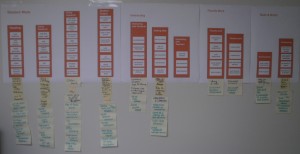In listening to people talk about what they need to have access to has got me thinking about how librarians are truly different from the people that they help on a regular basis. The needs of librarians and the people that they serve are very different even if a librarian states they are the same they are different. For example, if a person wants to check out a book from the library they just need to go to the circulation and show their library card to check it out. On the other hand a librarian or staff member need to do how to use the library system in place to do so.
The information that a librarian or staff member would need to know would best reside within an Intranet. For some people this may very obvious, but for other not so much. One thing that I have observed the past few months is that we as librarians want to provide more information than is necessary for a person to complete a task. I am just as guilty as the next person when it comes to providing someone with information.
This leads to a variety of new web services that will become available to librarians and staff on the libraries Intranet. The new additions are going to be:
- http://www.libraries.potsdam.edu/test – Will be used as a testing location for the library website. It will be a place to update content and make sure things look the way they are supposed to before moving the changes to the live web server.
- http://www.libraries.potsdam.edu/intranet – a residing place for all internal information
- http://www.libraries.potsdam.edu/intranet/bb – phpBB a bulletin board will be installed
- http://www.libraries.potsdam.edu/intranet/blog – WordPress blog will be installed
The first item will be used for the libraries website. At the moment there is no place that exists where things can be added without the world seeing them. Currently when an update is made the libraries website is made to the live web server ( you can imagine all of the problems this can cause). By having a test server (or sandbox if you prefer) will allow for a better process to take place in updating content by putting in place an editor who will be responsible for keeping things consistent.
Everything that resides on the Intranet will only need to be accessed by staff and nobody else. The bulletin board has come from the need for people to have discussions about various topics. Currently email is being used for discussions; However, it is not the most effective way because sometimes you may be included in a discussion that does not really pertain to you. It will be a great way for people to provide an opinion or make a recommendation in one location. The blog will be a great way for staff to communicate with each other in a different way. If someone is at a conference this would be a great place for them to share their thoughts with other people or a place to post information about a new resource that the library has purchased. It will be interesting to see how the blog will be used.
